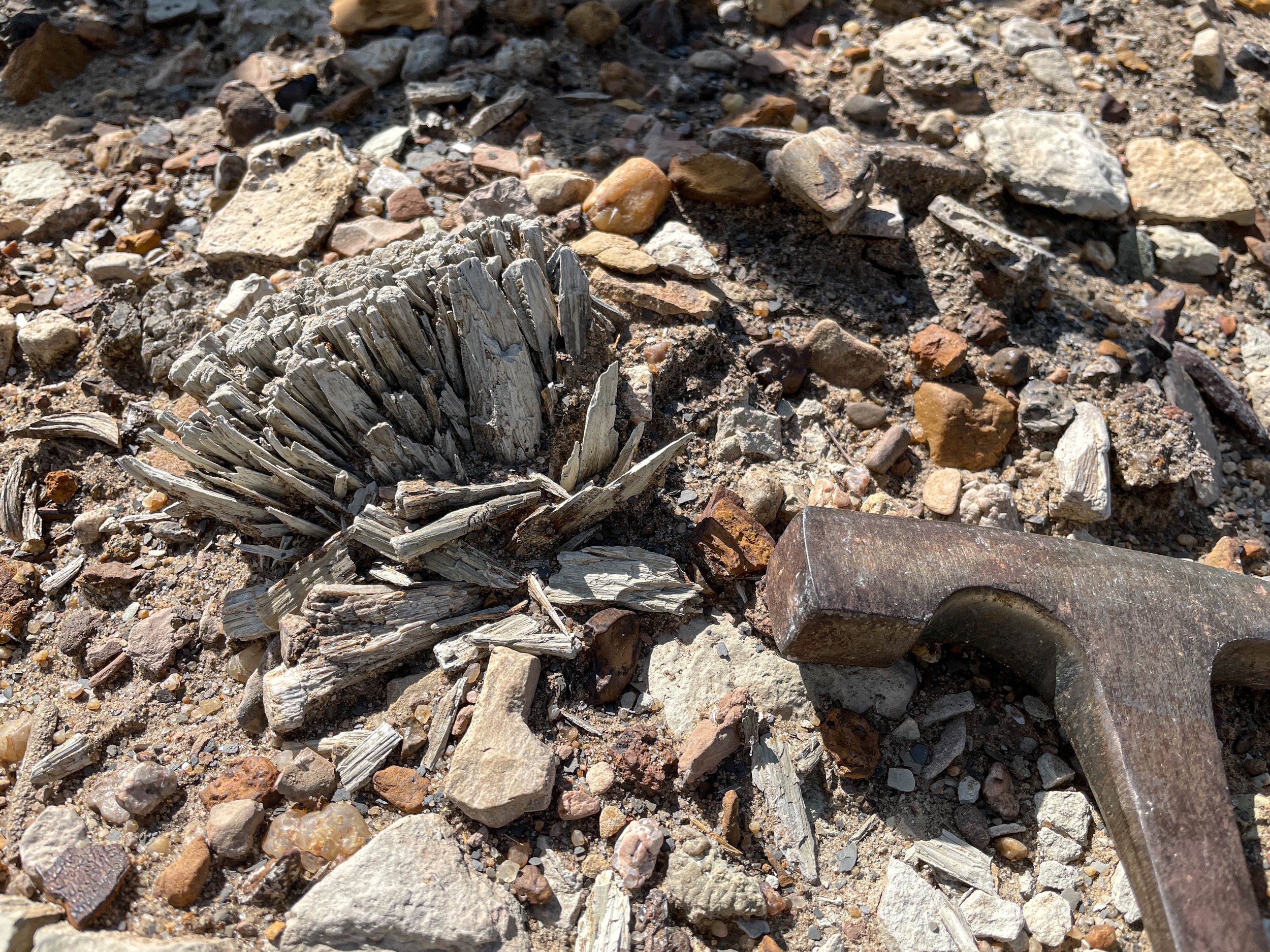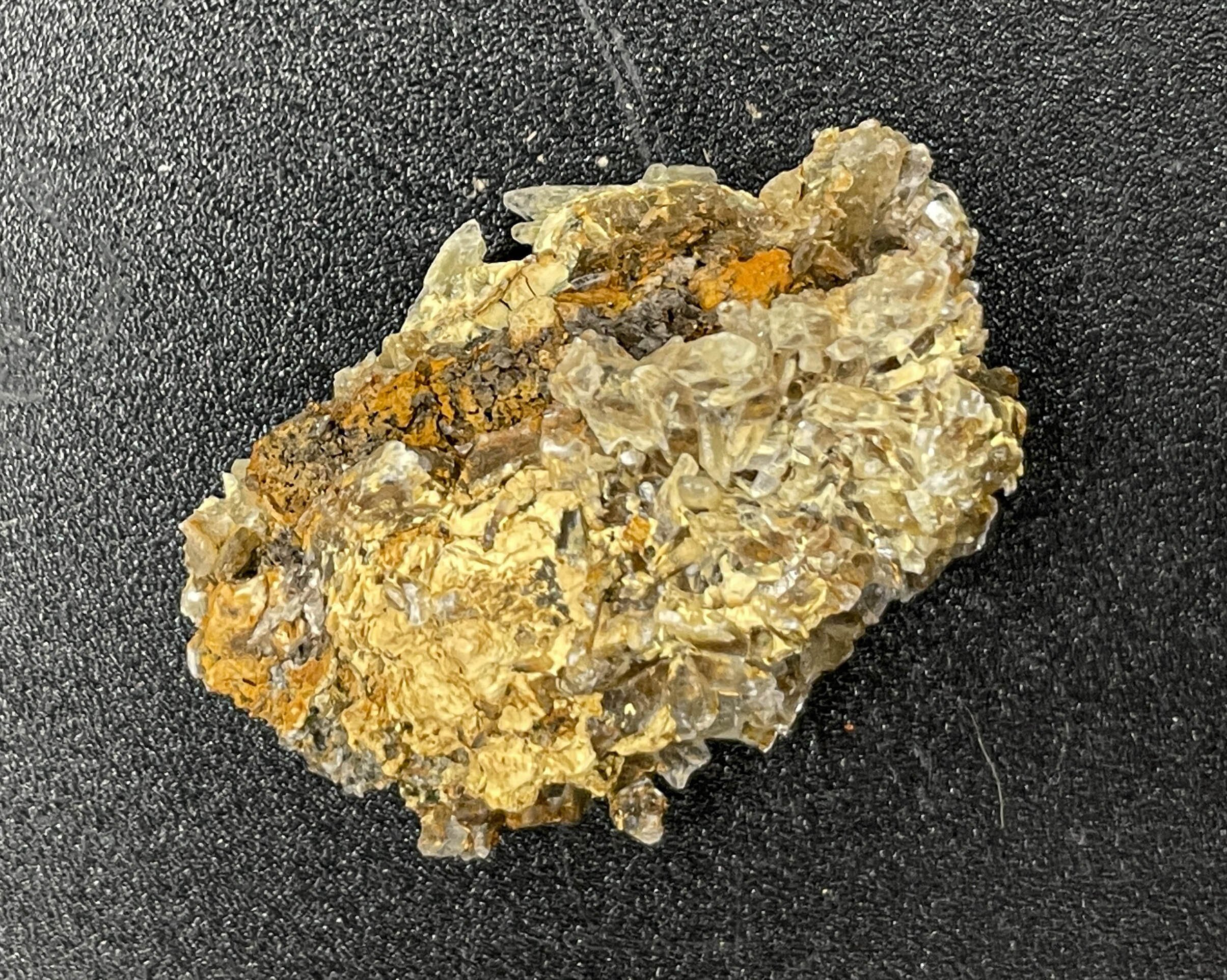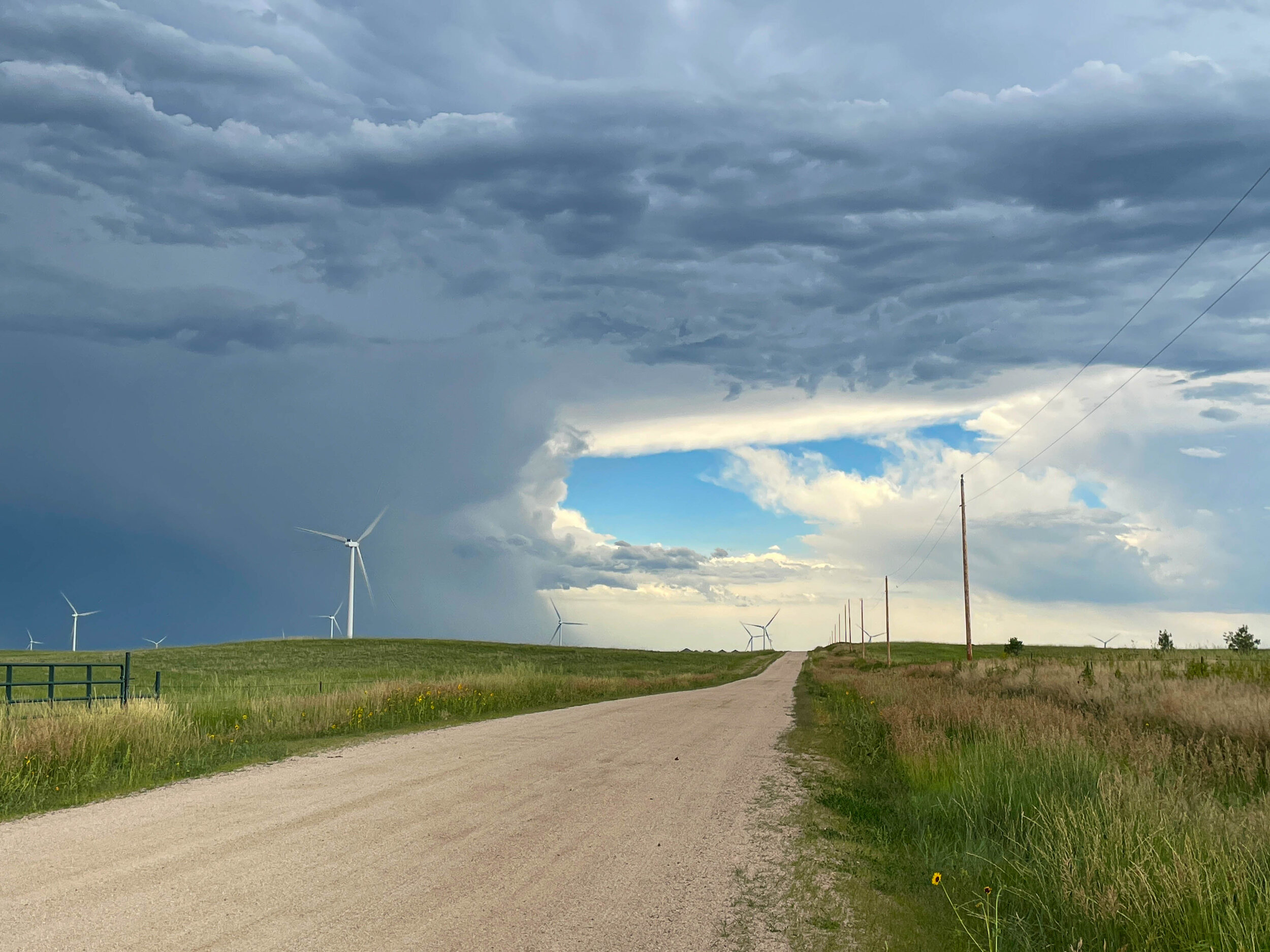Day 3 - Wednesday, 7/26/2023: Manhattan to Manitou Springs, CO
I knew when I pulled out of the hotel parking lot (just across the street from Kansas State) that I had to be in Colorado Springs by day’s end, so I had a few decisions to make on how to spend my time. First decision: take a detour south of 70 and head to the Kiowa Formation at Kanopolis Lake. I arrived at my first stop around 9:30. The lake level had dropped several feet from when my internet source had been there, and the beach trail he referred to more or less didn’t exist anymore. Instead, there was a wide “beachy” area of sand and rock and four-foot-tall weeds that trailed off into a swamp about 100 feet from what had been the shoreline. I am well aware that there are snakes in Kansas (four native poisonous species, to be precise), and as I contemplated the weedy mess before me, I almost chickened out. But the day before had been so damn disappointing, I grabbed my walking stick and started off, beating the weeds in front of me and chanting “Snakey, no snakey, no snakey” with every step, though whether to scare the snakes off or try to cast some sort of magic snake-repellant spell I’m not sure.
I’m probably overselling the weeds here. The density wasn’t grasslike; instead, each plant was several inches from the next stalk, and I could clearly see the ground between. I’d gone a quarter of a mile or so before reaching what I suspected was the end of the trail my source had described. Looking around, I figured day 3 was off to another non-rocky start, but then I looked a little more closely and found what I was looking for: barite roses. The ground was a-bloom with them, and I collected probably a few too many to make up for the scarcity of the previous day. I wandered around and collected roses and photos for about 30 minutes before I returned to the truck having neither seen nor been bitten by a snake. There were probably no snakes around in the first place, but I’m gonna hang onto that chant for the future . . . just in case!
Next, I drove to another part of the lake in search of cone-in-cone structures (this link does a great job of explaining what they are). I was not disappointed. I found numerous examples of these, along with Turritella (some exhibiting the same sort of fibrous structure that is seen in the cone-in-cone specimens), selenite (including a cool fishtail selenite cluster) and galena and/or white pyrite. I could have collected all day, but I had left my hat in the car and was dripping sweat in the hundred-degree heat--plus, I still had at least six hours to Colorado Springs . . . and potentially three more stops for the day. So after 30-45 minutes of collecting, I reluctantly tore myself away and pointed Barry to the northwest.
As I neared Hays, I made decision number two to pull off and visit the Sternberg Museum of Natural History. Affiliated with Ft. Hays State University, the museum is well-known in paleontological circles for its collection of Cretaceous and Permian flora and fauna, including numerous specimens from throughout Kansas. Before I set off on this expedition, I had begun reading Michael J. Everhart's Oceans of Kansas, which whetted my appetite for a stop. Everhart, a long-time curator at the facility and the discoverer of many of the specimens in its collection, maintains the Oceans of Kansas web site, which is chocked full of information about Kansas when it lay beneath the Western Interior Sea. The photos from his book sprang to life in the halls of the Sternberg: plesiosaurs, sharks, mosasaurs and the famous fish-within-a-fish fossil were all on display. I spent about an hour browsing the exhibits, taking a few hundred photos and enjoying the cool before heading out to the parking lot.
Would this be the last stop before Colorado Springs, or did I have time to hit one or two more places? With the AC cranked to max, I sat in the parking lot and ran some routes through Waze. Going to even one of the two spots I had in mind would require a detour of an hour and forty-five minutes, putting me at my hotel around 8:30. Considering that I would be driving unfamiliar roads and that it was, no joke, 106 degrees, I made decision number three and opted to let discretion be the better part of valor with a goal of making it to the hotel by 7. Maybe I could catch one or both places on the way home.
As I rolled west on I-70 and crossed into Colorado, the sky before me darkened with a line of late-afternoon storms rolling eastward off the Rockies. I left the interstate at Limon to pick up US Hwy 24, mildly irritated that 80 m.p.h. was down to 50 m.p.h. thanks to the two-lane road and the poky driver in front of me, but ultimately glad for the lower speed: it gave me more time to enjoy the view. I pulled off in several spots to take photos: the play of light through the clouds, a windmill, an empty gravel road threaded into infinity among green fields. The rain hit in earnest about the time I crossed into the Colorado Springs city limits, and I was grateful to find a small garage beneath the hotel so I could uncurl from the diver's seat and grab my bags without getting soaked. A shower later, the shower outside had ended, and I walked down the street to Adam's Mountain Cafe for a glass of Pinot Grigio and a bowl of mac and cheese. I watched the half moon move slowly across the skylight as I cleaned my plate then walked the two blocks back to the room I would call home for the next four nights.
Kansas Morning
Morning prairie on the way to Kanopolis Lake.
The Kiowa Formation at Kanopolis Lake.
The Kiowa from the lakeshore path.
The overgrown beach I was walking was wide-open prairie compared to this marshy stretch toward the lake. Snakey, no snakey, no snakey, no worries—not going in there!
This shot gives an idea of the weed density in the area I was walking. This is a bluestem prickly poppy.
Three barite roses clustered in their natural habitat.
Three of my best barite roses with a penny for scale.
Barite clusters take many forms other than roses, as you can see here.
Here’s a close-up of one of the non-rose barite clustes.
Here’s all the beautiful barite booty I gathered at my first stop at Kanopolis.
View of Kanopolis Lake from my second stop.
Cone-in-cone structures in the field. My first thought on looking at this and similar specimens was “petrified wood,” but then I “got my eyes” and picked up on the cone elements.
Here’s a cluster of cone-in-cone. You can, in this shot, begin to see a little of the detail.
These two specimens show the cone shape.
Here you can really see the texture of the cone-in-cone structures.
Used my macro lens to get super close to the specimen.
The area where I found the cone-in-cone structures is also part of the Kiowa Formation, and you can see what I believe to be barite crystals in this specimen.
The pinkish crystals on the right certainly look like barite, but I’m not so sure about the grayish crystals. They’re semitranslucent, but barite can be semitranslucent, and the crystalline structure definitely looks like barite.
Speaking of things I’m not sure about, I am not at all sure what I’m looking at here. If someone familiar with Kansas geology can weigh in in the Comments section, I’d appreciate it. This is the top of the specimen (though it could, I suppose, as easily be the bottom).
Here’s the bottom (or top?). I’m fairly certain one or more metals are contained in the specimen, but I don’t know enough about metals to formulate a good guess. I do know white pyrite and galena can be found in this part of Kansas, but not sure if that’s what we’re looking at here.
You can’t see it very clearly, but there’s a cubic structure to the crystals in this specimen, leading me to believe it’s galena.
I believe this is a cluster of gypsum crystals. Not sure if the yellow coating is sulfur or something else. You can see some pretty nice crystal definition at the top of the photo.
This is the backside of that same specimen with the same crystal structure at the top. I learned quickly to handle the specimens of this mineral with care; they will break if you look at them the wrong way.
Here are some of the selenite crystals I picked up.
I’d never seen fishtail selenite before, so this blew me away when I picked it up.
Here’s another view of the fishtail selenite. I’m scared to clean it since water can harm it, but I know it will look a lot more beautiful than its current state if I figure out how to clean it up.
Here are some Turitella. My online source says the shells have largely been replaced by pyrite.
A few Turitella with a penny for scale.
Here’s a close-up of one of the Turitella to show its texture.
I always feel like a little kid when I see wind turbines like these along I-70. They’re so tall they make me feel totally out of scale with the land. But they have a sort of otherworldly beauty: silent, gracile flowers, arms spinning at the slightest wind.
Check out the temp on Barry’s instrument cluster!
I didn’t take pictures of every mineral at the Sternberg, but I was delighted to find their calcite specimen was from the Elmwood Mine in Tennessee!
This lower valve of a fossil clam (Platyceramus platinus) at the Sternberg is four feet in diameter. Hold on to this thought for Day 7.
This pteranodon, Nyctosaurus bonneri, once flew above the Western Interior Sea. Hold on to the species name for Day 7 as well.
You can’t see much detail here, but this is likely a lot closer to a mosasaur as you would want to get if you found yourself tossed back in time to the Cretaceous!
This is probably the most famous fossil at the Sternberg, the fish-within-a-fish fossil. Pretty damn amazing!
The skies in this part of the country are awesome. Photography at 80 mph is not the height of vehicle safety, but I couldn’t resist snapping this out the driver’s side window as I headed west on I-70.
This shot was actually taken a few minutes after the shots below and shows the sky a bit further west along US 24 in Colorado.
I mean, damn, how crazy is this?
So crazy I couldn’t resist sharing a portrait view of the same scene. Eye of the storm indeed.
The present provides a backdrop to the past with this shot of a windmill in the foreground and a row of wind turbines behind.
Follow the road to my first glimpse of the Front Range.
I demolished this bowl of mac and cheese at Adam’s Mountain Cafe . . .
, , , and watched the half moon slowly slide across the sky as I ate my dinner.












































